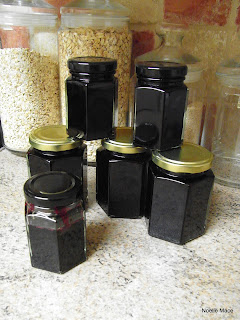With a heavy bag of fresh vegetables from the market, and a bag full of pretty purple shallots from Waitrose, I spent a Thursday evening in preparation...weighing, chopping into small pieces, and salting.
The next evening, with the vegetables shrunk, and standing amongst a salty brine, it was time to mix up the spices and vinegar, and start the sauce, finish off the pickle and pot it up in sterilised jars.
I had posted this on my facebook page, and my nephew contacted me for the recipe. I had adapted the one from The River Cottage Handbook: Preserves. As he is in Spain where the vegetables are so plentiful, I hope that he will try this. There are many variations, and I do have a recipe with no sugar, but most of the versions of Piccalilli which I have tasted in the UK have some sweetness.
This chutney goes back to the days when British Colonialists came back from India and wanted to replicate the chutneys they had enjoyed. It goes so well with cold meats, Pork Pies. and in a cheese sandwich too. With the crunchiness of the veg which should remain, together with the slightly sweet vinegary taste, Piccalilli is a great compliment to both raw and cold cooked vegetable salads, and beans.
For this batch I used the following:
1 Large Cauliflower, with the following added to make up 1.5Kg of vegetables
French Beans
courgette
Carrots,
Shallots
75g fine pure sea salt
Cut the above vegetables, it took me over an hour to prepare the vegetables, then put them in a covered glass or plastic container, or large plastic bag, mix in the salt, and leave for 24 hours turning occasionally. Then wash quickly in very cold water, drain and preferably swish in a salad spinner, or squeeze with a clean boiled tea towel to remove as much water as possible. Do this just before you are ready to turn the veg into the prepared sauce.
Before you make the sauce, find your jars, and lids. Wash them in very hot soapy water and rinse well, then drain, and sterilise and dry by putting them in a low oven for about 10 minutes. Don't do this with the lids. I put the lids into boiling water, then put the dish with lids in the oven. Dry the lids before using with fresh paper towels. Use warm jars to fill with the chutney.
Sauce
40 g cornflour
10g ground turmeric
10g English Mustard Powder, or finely ground and sifted pale mustard seeds
15g whole yellow mustard seeds
1 tsp cumin seeds
1tsp ground dried coriander seed
800ml organic cider vinegar, one could use white wine vinegar or light coloured alternative
150g golden caster sugar, or any other light sugar
50g honey.
Blend the spices with the cornflour, and dampen down with some cold vinegar, mix to a loose paste.
Add the rest of the vinegar, sugar and honey to a large pan, and bring to the boil. Reduce the heat to gentle, and carefully pour the spice and cornflour mixture into the vinegar stirring all the time, stir till thickened, and continue to boil gently for 3 to 4 minutes, stirring all the time.
Remove the pan from the heat, and carefully stir in the vegetables into the hot sauce. Fill your sterilised jars with the mixture and press down making sure there is plenty of sauce to cover the vegetables. Seal immediately with vinegar proof lids.
These are lids which have a plastic membrane and stop the vinegar from attacking a metallic lid, or it could be a plastic lid, but this has to be air tight.
This chutney is reminiscent of the Achard which we used to eat in Mauritius and which I have had a go at a couple of years ago. Unlike Achard, which can be eaten within days and which is usually refrigerated as there is much less vinegar, Piccalilli needs time to mature, 4 to 6 weeks, and unopened, it can be stored in a cool dark place, and is good for up to a year.
The sauce is much more yellow than that of Piccalilli in the shops, but with turmeric being a beneficial spice, I do not think I would want to reduce the quantity. One can use ordinary flour too, but as a friend of mine cannot tolerate gluten, so I chose the cornflour option.
You may use a variety of vegetables, and there are many recipes on line which give ideas. One could also make a smaller proportion back to 1/2 Kg of prepared vegetables for just one large jar. My Cordon Bleu Book of Jams, Preserves and Pickles suggests: in addition to cauliflower,and onions, which seem to be the constant in all the recipes I have looked up: cucumbers, marrow. Elsewhere I have seen butternut squash, pumpkin, capers, nasturtium seeds.....
I would like to make a green and white version next time, with Romanesco cauliflower and white cauliflower, small white onions, and other green and white vegetables.







































